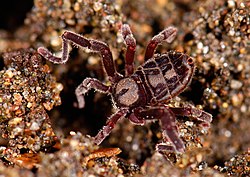| Cryptocellus | |
|---|---|
 | |
| Cryptocellus goodnighti | |
| Scientific classification | |
| Kingdom: | Animalia |
| Phylum: | Arthropoda |
| Subphylum: | Chelicerata |
| Class: | Arachnida |
| Order: | Ricinulei |
| Family: | Ricinoididae |
| Genus: | Cryptocellus Westwood, 1874 |
| Type species | |
| Cryptocellus foedus Westwood, 1874 | |
| Species | |
45, see text | |
| Synonyms | |
| |
Cryptocellus is an arachnid genus in the order Ricinulei, first described by John Westwood in 1874. It is native to the Neotropics. [2]